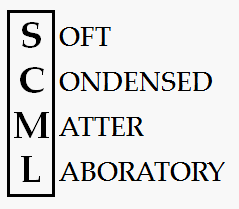Breaking of Toroidal Droplets Inside Viscoelastic Materials
Hung Le, Ekapop Pairam, and Alberto Fernández-Nieves
Experiment Procedure & Goal
My experiment aims to study the characteristics of a toroidal droplet that is nonstable. Previously, author Ekapop Pairam conducted research on the boundary between breaking and stabilizing of a toroidal droplet [1]. I used his same method for generation of a toroidal droplet: a needle inject liquid into a viscoelastic medium contained in a rotating bath. A syringe pump is used to inject the liquid, so the droplet's volume can be controlled. By gradually decreasing the volume, I can produce droplets that are unstable and eventually retract into a crescent shape. The retraction takes a long period, so tori are all covered in parafilm and allowed to fully retract after they were made. The process is captured by a camera positioned below the bath, and snapshot of each fully retracted torus is taken to allow for data collection.
Data
From the data collected, we can see that the tube radius at the end of a crescent-shaped torus (the average is taken, since there are two ends) is constant for various initial radius. Fig 1 shows the plot for various characteristics of the final state against the initial tube radius, where af is the radius where the radius is thickest, ab is the radius at the tip, and as is in the middle between the two. We can see that the value for ab is more constant than the others, which averages around 0.4mm. With that discovery, we're able to formulate a relationship between the initial state and final state of a torus by using volume. The volume of a torus is well known and can be calculated by measuring the inner radius and the tube radius of a torus. The volume of the crescent can be calculated by measuring the arc length and the tube radius at the end. Since the volume of a torus is constant, we plotted the initial volume against arc length and compare it to a hypothetical line of what the final volume should be. Fig 2 shows a visualization of this.

|

|
Fig 3 shows the relationship between initial volume and arc length compared against the hypothetical final volume. The data is consistent with the slope. It is reasonable that the actual data is above the line, as most tori expand in the middle as they contract; the ones far off the line are more bulked up than the ones near the line. Fig 4 augments the data with some pictures of the tori used in the plot.

|

|
Future Project
Using my experience in controlling the size of tori, I will be making nematic droplets with handle (a figure eight), which is also a continuation of another project previously done by Ekapop Pairam [2]. In his project, he discovered that a figure eight has two negative topological defects, while a single torus has no defect. I will be making figure eights where one ring is stable and another break and study how the two defects evolve.
References
[1]E. Pairam, A. Fernández-Nieves. Generation and stability of toroidal droplets in a viscous liquid. Phys. Rev. Lett., 102 (2009), p. 234501
[2]E. Pairam, J. Vallamkondu, V. Koning, B. C. van Zuiden, P. W. Ellis, M. A. Bates, V. Vitelli, A. Fernández Nieves. Proceedings of the National Academy of Sciences of the United States of America, 110 (2013), p. 9295-9300












